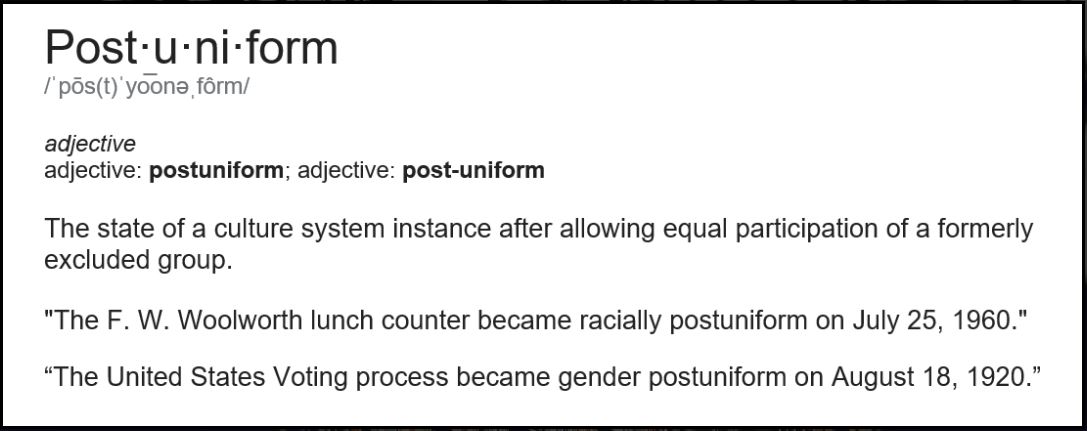
In 2020 a new social theory is sweeping the sociology circles. They call it Postuniform Analysis and it provides a new framework for culture change.
First there are a few new words used by the theory to simplify comprehension:
Culture System: Any human created entity or process that interfaces with humans and has rules or procedures for that human interaction.
Postuniform: The state of a culture system instance after allowing equal participation of a formerly excluded group.
In brief, the theory states that each culture system was created by a small group of people with similar attributes. During creation and codification of initial rules for their culture system, the founders focused their rule creation on self-benefit. To that end they created a uniform set of rules to benefit themselves; rules that if adhered to would exclude equal participation in the culture system by outsiders. Exclusion often was not the original intent, but rather the outcome of limited comprehension possessed by the founders when the initial rules were drafted.
As a culture system became prevalent it replicated itself into instances, with each instance under the control of a ruling body able to make decisions for that instance with a certain degree of autonomy. These culture system instances replicated the initial culture system’s rules, passing along policies and procedures that were written and adapted by men who did not possess enough information to make fully informed rules.
As culture system instances are challenged with new expectations, there emerges a tension between adherence to the rules of the instance and the new information that seeks to be included into the rules. A culture system that modifies its policies and procedures to give equal footing to the new information is said to be Postuniform in relation to that information. As culture system instances have differing levels of devotion to original founding rules, it is possible to see that culture system instances are bound to have conflict with emerging information proportional to their inflexibility to become Postuniform.
Because Culture Systems are the basis for all social-cultural tradition, the process of modifying culture systems is particularly difficult due to the trained nature of the culture participants. As a culture system becomes prevalent and the education-cost of training a population to a culture system has been expended, participants ardently defend the practices of the culture system and culture system instances. Deviation from culture system rules is seen as non-conformist, anti-social, or deviant. Because a culture system is as much a construct in the minds of the participant as it is a construct of a founder or owner of a culture system, change to the construct’s rules will inevitably require the costs of re-education of the culture participants.
While some culture system instances are agile in their transition to Postuniform states, most CSIs experience difficulty in re-education sufficient to allow for an expedient transition. The ideal path forward to enable faster Postuniform transitions across culture is the blanket education of Postuniform Analysis. By teaching each person who interfaces with a culture system about Postuniform Analysis, it is possible to provide each participant language to assess the state of each CSI and to lodge an easily understood complaint. This language allows any group of outsiders or CSI outcasts, to change roles and become informers of culture. Postuniform Analysis provides the ability to explain a system in its present state and to highlight the conditions in which it is still uniform. When a population is taught to address uniformity of a culture system in this way, their complaints are easily understood by all people, not just members of their specific sub-population.
While most people are not advisedly prejudiced, their internal programming has been taught to them by Culture Systems containing rule-based bias. This bias is internalized on the CSI process level and cultural participants of a CSI adapt to the cultural expectations, leading to the unwitting acceptance of cultural bias. Preservation of CSI process is seen as a duty for the adherents of its culture and a means to maintain the right to participate in a cultural system. A CSI’s survival is likewise linked to the participants continued willingness to engage with the CSI. Whereby cultures that require a great deal of investment from a participant also require a great deal of adherence to its rules; thereby making culture change more difficult and increasing the demands for uniform conduct, thoughts, beliefs and behavior. Whereas, CSIs that do not demand high levels of investment are more prone to become Postuniform as their reliance on maintaining a functional relationship with participants is more elastic.
Postuniform theory’s main argument is that by educating people on Postuniform critique it is possible to heighten awareness of the commonality of any outside or marginal groups complaints against a Culture System, thereby turning disparate outside groups into informed allies. In addition, educating founders and CSI owners on Postuniform critique enables faster conflict resolution and Culture System reform leading in the end to the integration of Postuniform Theory into the processes of Culture Systems and thereby enabling continual self-critique.























